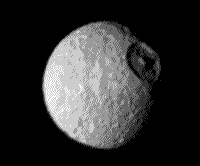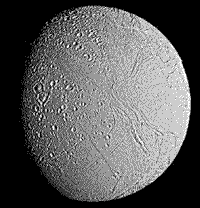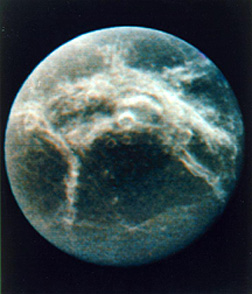

Saturn and its Moons
Now, on with the Tour! Both Voyager spacecraft observed the second largest planet, Saturn (diameter 84.3% that of Jupiter and 10% shorter at the poles). When the spacecraft were slightly above the rings, on the sunlit side, this planet presented a stunning image:
The rings begin about 7,000 km (4,350 mi) beyond the planet's discernible atmospheric edge and continue for another 74,000 km (45,984 mi), to the faint F ring (discovered by Voyager), a diameter of greater than 260,000 km (161,564 mi). But, the entire system is only about 1.5 km (about 1 mile) thick. We show details of the ring structure in this color-enhanced version, made by assigning red, green, and blue to clear, orange, and ultraviolet image frames, respectively. We chose it for its esthetic quality and to help distinguish its ring divisions:
Note the many dark bands, which are gaps with lower densities, composed of particles in the centimeter to meter size range. The visible rings consist of ice and ice/rock fragments that (although spread apart) reflect sunlight. The inner blue region marks the C ring. Beyond it is the B ring, whose inner part is orange and outer is greenish-blue. There is a large dark area known as the Cassini division (a gap) that separates the B ring from the outer (purplish) A ring. A smaller gap, named the Encke gap, subdivides the A ring. Although not visible in this image, parts of rings (mainly in B) contain "spokes", which are narrow darker linear "shadows" that lie perpendicular to the bands. These may be density discontinuities or clusters of small particles levitated above the residual larger particles in the rings by electrostatic charging.
The origin of Saturn's rings is still unsettled. The materials may be even now in the process of organizing into a satellite or could be residual materials around Saturn that never succeeded in building into a single large body. Or they might be debris from a large impact that shattered an earlier satellite. Or they could be the residue of a pre-existing satellite that moved so close to Saturn that the planet's tidal forces disrupted it (the distance at which such break up must occur is called the Roche Limit; for Saturn this is 1.5 times the planetary radius; for the Earth-Moon system it is 2.44 times Earth's radius).
At least the outer rings, A and F, are kept from drifting apart by the action of three small satellites orbiting close to them. Called "Shepherd Satellites", their gravitational focusing acts to push straying particles back in line. Their action also may cause the braiding observed in the A ring.
19-63:
Saturn has about the same composition as Jupiter, but lower internal pressures and temperatures (up to about 12,000° C) may limit the extent of the metallic hydrogen zone . Its density, about 0.7 gm/cm3, is the lowest of any planet. Saturn's thin surficial atmosphere, although moderately banded, lacks the reddish coloration typifying Jupiter's belts, but its yellowish color is similar to the Jovian zones. Circulation patterns, driven by jet streams, are also similar, including oval spots, cyclonic storms, eddies, and swirls.
Saturn has 17 satellites. All but one (Iapetus), orbit close to the planet's equatorial plane. Seven of these are spherical moons, ranging in diameter from about 400 km to 5,100 km (249 mi—3,169 mi). Their names, in orbital-position order, starting at the innermost, are Mimas, Enceladus, Tethys, Dione, Rhea, Titan, and Iapetus. The remainder are smaller and have irregular shapes (although Phoebe is nearly spherical), and are mixtures of ice and water. Of the larger ones, six appear to consist almost entirely of water ice, but interior compositions are unknown. The seventh and largest, Titan, seems completely different, as we describe below. Most of the satellites have synchronous, prograde (orbiting in the direction of the planet’s rotation) orbits, locked by Saturn's gravity that causes each satellite's rotational period and revolution (about Saturn) to coincide. That means the same hemisphere always faces the inner planet (as the Moon faces the Earth). We will look at one or two representative images of each of the big seven, describing the satellite briefly.
Mimas is only 392 km (244 mi) in diameter. Its surface holds innumerable small craters. Because of the 136 km (84.5 mi)-wide crater, Herschel (approaching a size where disruption might have occurred), with its cyclopean eye-like visage, it resembles the Death Star ship in the Star Wars movie series with a special mystique.

The larger (501 km [311 mi] diameter) Enceledus is the brightest object, in terms of albedo, in the solar system. This brightness suggests regions of fresh or uncontaminated ice.

Five distinctive terrains are visible on this satellite: 1) Smooth Plains (craters sparse) 2) Cratered Plains (relatively few craters); 3) Cratered Terrain (more craters but still less than the other ice satellites, implying a rather young surface); 4) Ridged Plains (subparallel ridges); 5) Grooved Terrain (including graben-like, straight to curvilinear depressions). Some of these features are indicative of tectonic stressing of a brittle crust underlain by liquid, with the energy to fracture it coming from bulging in response to tidal interaction with Dione, which orbits in resonance with Enceladus.
19-64:
Tethys is a heavily cratered satellite (diameter = 1,060 km [659 mi]), on which appears a very large (about 400 km [249 mi] diameter) impact structure called
Odysseus is a very large (about 500 km [310 mile] diameter) impact structure on the other side of Tethys whose rim and central peak have dissipated under viscous flow.

A huge valley, 2,000 km (1,243 mi) long, 100 km (62 mi) wide, and up to 5 km (3 mi) deep, known as Ithaca Chasma, suggests that the ice cracked at some stage, perhaps when rifting occurred, as water converted to contracting ice that redistributed tension.
The slightly larger (1,120 km [696 mi]) Dione has two, dissimilar hemispheres: on one side, the leading hemisphere (because of synchronous locking, where the same side always faces the direction of the advancing orbit), the surface is heavily cratered and fractured, with a uniformly medium bright tone.
The other side, the trailing hemisphere, is darker, has a much lower crater density, and contains broad, very bright streaks in a diffuse network. We believe this strange pattern is frost and ice, expelled or extruded from fissures, and possibly from ice volcanoes, in which the water is the "lava" in an otherwise frozen structure.

19-65:

Primary Author: Nicholas M.
Short, Sr. email: nmshort@epix.net
Contributor Information
Last Updated: September '99
Site Curator: Nannette Fekete